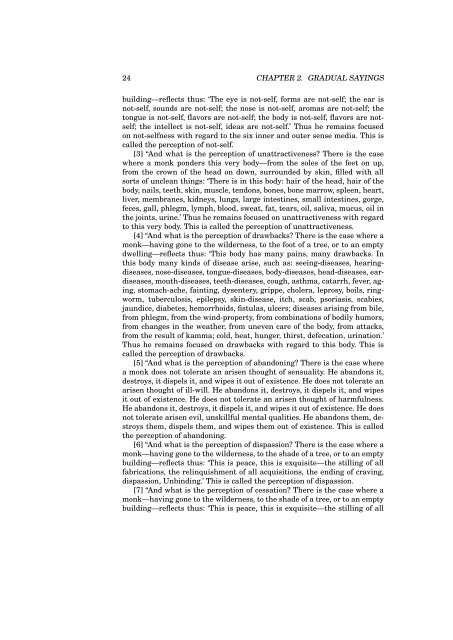Philosophy 438 Indian Buddhist Philosophy Buddhist Views of the ...
Philosophy 438 Indian Buddhist Philosophy Buddhist Views of the ...
Philosophy 438 Indian Buddhist Philosophy Buddhist Views of the ...
Create successful ePaper yourself
Turn your PDF publications into a flip-book with our unique Google optimized e-Paper software.
24 CHAPTER 2. GRADUAL SAYINGS<br />
building—reflects thus: ‘The eye is not-self, forms are not-self; <strong>the</strong> ear is<br />
not-self, sounds are not-self; <strong>the</strong> nose is not-self, aromas are not-self; <strong>the</strong><br />
tongue is not-self, flavors are not-self; <strong>the</strong> body is not-self, flavors are notself;<br />
<strong>the</strong> intellect is not-self, ideas are not-self.’ Thus he remains focused<br />
on not-selfness with regard to <strong>the</strong> six inner and outer sense media. This is<br />
called <strong>the</strong> perception <strong>of</strong> not-self.<br />
[3] “And what is <strong>the</strong> perception <strong>of</strong> unattractiveness? There is <strong>the</strong> case<br />
where a monk ponders this very body—from <strong>the</strong> soles <strong>of</strong> <strong>the</strong> feet on up,<br />
from <strong>the</strong> crown <strong>of</strong> <strong>the</strong> head on down, surrounded by skin, filled with all<br />
sorts <strong>of</strong> unclean things: ‘There is in this body: hair <strong>of</strong> <strong>the</strong> head, hair <strong>of</strong> <strong>the</strong><br />
body, nails, teeth, skin, muscle, tendons, bones, bone marrow, spleen, heart,<br />
liver, membranes, kidneys, lungs, large intestines, small intestines, gorge,<br />
feces, gall, phlegm, lymph, blood, sweat, fat, tears, oil, saliva, mucus, oil in<br />
<strong>the</strong> joints, urine.’ Thus he remains focused on unattractiveness with regard<br />
to this very body. This is called <strong>the</strong> perception <strong>of</strong> unattractiveness.<br />
[4] “And what is <strong>the</strong> perception <strong>of</strong> drawbacks? There is <strong>the</strong> case where a<br />
monk—having gone to <strong>the</strong> wilderness, to <strong>the</strong> foot <strong>of</strong> a tree, or to an empty<br />
dwelling—reflects thus: ‘This body has many pains, many drawbacks. In<br />
this body many kinds <strong>of</strong> disease arise, such as: seeing-diseases, hearingdiseases,<br />
nose-diseases, tongue-diseases, body-diseases, head-diseases, eardiseases,<br />
mouth-diseases, teeth-diseases, cough, asthma, catarrh, fever, aging,<br />
stomach-ache, fainting, dysentery, grippe, cholera, leprosy, boils, ringworm,<br />
tuberculosis, epilepsy, skin-disease, itch, scab, psoriasis, scabies,<br />
jaundice, diabetes, hemorrhoids, fistulas, ulcers; diseases arising from bile,<br />
from phlegm, from <strong>the</strong> wind-property, from combinations <strong>of</strong> bodily humors,<br />
from changes in <strong>the</strong> wea<strong>the</strong>r, from uneven care <strong>of</strong> <strong>the</strong> body, from attacks,<br />
from <strong>the</strong> result <strong>of</strong> kamma; cold, heat, hunger, thirst, defecation, urination.’<br />
Thus he remains focused on drawbacks with regard to this body. This is<br />
called <strong>the</strong> perception <strong>of</strong> drawbacks.<br />
[5] “And what is <strong>the</strong> perception <strong>of</strong> abandoning? There is <strong>the</strong> case where<br />
a monk does not tolerate an arisen thought <strong>of</strong> sensuality. He abandons it,<br />
destroys, it dispels it, and wipes it out <strong>of</strong> existence. He does not tolerate an<br />
arisen thought <strong>of</strong> ill-will. He abandons it, destroys, it dispels it, and wipes<br />
it out <strong>of</strong> existence. He does not tolerate an arisen thought <strong>of</strong> harmfulness.<br />
He abandons it, destroys, it dispels it, and wipes it out <strong>of</strong> existence. He does<br />
not tolerate arisen evil, unskillful mental qualities. He abandons <strong>the</strong>m, destroys<br />
<strong>the</strong>m, dispels <strong>the</strong>m, and wipes <strong>the</strong>m out <strong>of</strong> existence. This is called<br />
<strong>the</strong> perception <strong>of</strong> abandoning.<br />
[6] “And what is <strong>the</strong> perception <strong>of</strong> dispassion? There is <strong>the</strong> case where a<br />
monk—having gone to <strong>the</strong> wilderness, to <strong>the</strong> shade <strong>of</strong> a tree, or to an empty<br />
building—reflects thus: ‘This is peace, this is exquisite—<strong>the</strong> stilling <strong>of</strong> all<br />
fabrications, <strong>the</strong> relinquishment <strong>of</strong> all acquisitions, <strong>the</strong> ending <strong>of</strong> craving,<br />
dispassion, Unbinding.’ This is called <strong>the</strong> perception <strong>of</strong> dispassion.<br />
[7] “And what is <strong>the</strong> perception <strong>of</strong> cessation? There is <strong>the</strong> case where a<br />
monk—having gone to <strong>the</strong> wilderness, to <strong>the</strong> shade <strong>of</strong> a tree, or to an empty<br />
building—reflects thus: ‘This is peace, this is exquisite—<strong>the</strong> stilling <strong>of</strong> all
















